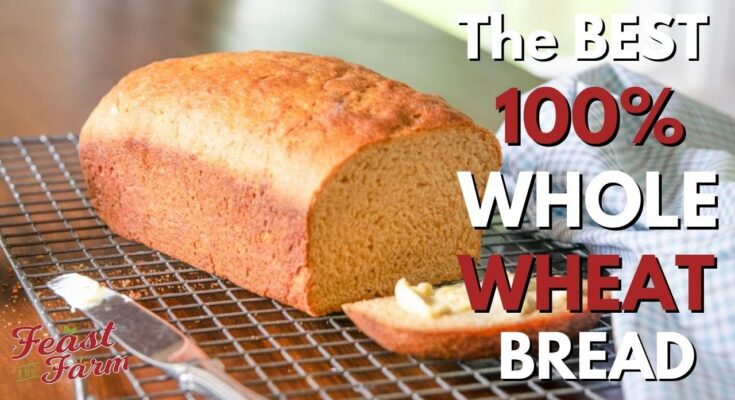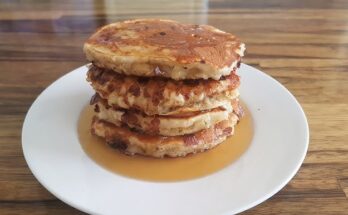Wheat Bread Recipe: Let’s be honest—store-bought bread just doesn’t compare to the warm, soft, crusty slice you make in your own kitchen. Making your own wheat bread might sound intimidating, but it’s actually one of the most rewarding and relaxing kitchen experiences out there. Once you try it, you might never go back to pre-packaged loaves again.
Wheat bread is not only tasty but also a healthier alternative to white bread. It’s higher in fiber, has more nutrients, and keeps you fuller for longer. Plus, when you make it at home, you have full control over what goes in—no preservatives, artificial flavors, or unknown ingredients.
Homemade wheat bread is perfect for sandwiches, toast, or just eating fresh out of the oven with a pat of butter. It’s rustic, rich in flavor, and surprisingly easy to make with just a few ingredients.
Ingredients Needed for Wheat Bread
Getting the ingredients right is the first step to baking a beautiful loaf. Here’s what you’ll need for a classic whole wheat bread:
Essential Ingredients:
- 3 cups whole wheat flour – This is the base of your bread. Go for freshly ground or organic if possible for the best flavor.
- 1 cup warm water – Not too hot! You want it around 110°F to activate the yeast without killing it.
- 2 ¼ teaspoons active dry yeast – This helps your bread rise and get nice and fluffy.
- 2 tablespoons honey – Adds a touch of sweetness and helps feed the yeast.
- 2 tablespoons olive oil (or any neutral oil) – Keeps the bread moist and tender.
- 1 teaspoon salt – For flavor and structure.
Optional Additions:
- Ground flaxseed or chia seeds – For added fiber and nutrition.
- Rolled oats or sunflower seeds – Add texture to the top crust.
- Milk instead of water – For a softer crumb.
- Butter instead of oil – For a richer taste.
Always measure your ingredients accurately. Baking is a science, and the balance of wet to dry ingredients affects the texture and structure of your bread.
Tools and Equipment You’ll Need
You don’t need a fancy bakery setup to make great wheat bread at home, but having the right tools will make the process smoother and more enjoyable.
Basic Tools:
- Large mixing bowl – For combining your ingredients.
- Wooden spoon or spatula – To stir the dough.
- Measuring cups and spoons – Precision matters in baking.
- Clean kitchen towel – For covering the dough while it rises.
- 9×5-inch loaf pan – Standard size for a classic loaf.
Optional but Helpful:
- Stand mixer with dough hook – Makes kneading much easier if you’re making multiple loaves.
- Instant-read thermometer – To check the temperature of your water or your finished loaf.
- Bench scraper – Helpful for kneading and shaping the dough.
A well-prepped kitchen saves time and reduces stress. Lay out everything you need before you start so you can focus on the fun part—baking!
Preparing the Dough
This is where the magic begins. Making dough is all about bringing together the simple ingredients you prepared into something truly special.
Step-by-Step Dough Prep:
- Activate the yeast: In a small bowl, mix warm water and honey. Sprinkle the yeast over the top and stir gently. Let it sit for 5–10 minutes until it becomes frothy. That means your yeast is alive and ready to work its magic.
- Combine dry ingredients: In a large bowl, mix your whole wheat flour and salt. If you’re adding seeds or other dry extras, now’s the time.
- Add the wet ingredients: Pour in the activated yeast mixture and olive oil. Stir with a wooden spoon until the dough starts to come together.
- Knead the dough: Turn it out onto a floured surface and knead for about 8–10 minutes. You’re looking for a smooth, elastic dough that bounces back when poked.
- Too sticky? Add a little more flour, one tablespoon at a time.
- Too dry? Sprinkle a little water and knead it in.
Don’t rush the kneading—it’s what gives your bread its structure and chew. Treat the dough with love, and it’ll reward you with an incredible loaf.
First Rise – Letting the Dough Rest
This part of the process is all about patience. You’ve done the hard work kneading—now let the yeast do its thing.
How to Let It Rise:
- Lightly oil a clean bowl and place the dough inside, turning it so it’s coated with oil. This prevents sticking.
- Cover the bowl with a damp kitchen towel or plastic wrap.
- Set the bowl in a warm, draft-free area (like inside a turned-off oven with the light on).
Let it rise for 1 to 1.5 hours, or until it has doubled in size. You’ll know it’s ready when you gently press a finger into the dough and the indentation stays.
This first rise, also called “proofing,” allows the yeast to develop flavor and structure in the dough. The wait might be a test of patience, but it’s essential for a perfect loaf.
Punching Down and Shaping the Dough
After your dough has risen to double its size, it’s time to give it a good punch—literally. This step is both fun and important.
Here’s What to Do:
- Gently deflate the dough by pressing your fist into the center. This helps release some of the gas built up by the yeast.
- Turn the dough onto a lightly floured surface and knead it just a few times to redistribute the yeast.
- Shape the dough into a loaf. Tuck the edges under and shape it into a rectangle, roughly the size of your loaf pan.
- Grease your loaf pan and place the shaped dough inside, seam side down.
At this point, the dough should be fairly soft but hold its shape. You don’t want it to be too tight or too loose in the pan—it should fill it about halfway. This step sets the stage for a nice, even rise during the second proof and a beautiful final loaf.
Second Rise – Final Proofing
Now that the dough is in the pan, you’re almost at the finish line. But before baking, the dough needs one last rest to rise again.
Letting the Dough Rise Again:
- Cover the loaf loosely with a towel or plastic wrap.
- Let it rise in a warm, draft-free place for about 30 to 45 minutes.
- The dough should rise just above the rim of the pan.
This second rise is shorter than the first, but just as crucial. It gives your loaf a final boost, ensuring it’s light and fluffy rather than dense. Be careful not to over-proof it, though, or your loaf might collapse during baking.
How do you know it’s ready? Gently press a finger into the dough—if it springs back slowly and leaves a small indentation, it’s good to go!
Baking Your Wheat Bread
Here’s where the transformation happens—where dough becomes golden, crusty, delicious bread.
Baking Instructions:
- Preheat your oven to 375°F (190°C) about 15 minutes before baking.
- Place your loaf in the center of the oven and bake for 30 to 35 minutes.
- Check for doneness by tapping the top of the loaf. If it sounds hollow, it’s ready.
- For extra accuracy, use a food thermometer: the internal temp should be around 190°F to 200°F.
Don’t forget to rotate the loaf halfway through for even baking if your oven has hot spots.
The smell? Incredible. This is where the excitement peaks—watching your homemade wheat bread turn golden brown and knowing you did it from scratch.
Cooling and Slicing
It’s tempting to cut into that warm loaf immediately, but patience pays off here, too.
Proper Cooling:
- Remove the bread from the pan and place it on a wire rack.
- Let it cool for at least 1 hour before slicing.
Why the wait? Cutting too soon can make the bread gummy or collapse slightly. Cooling helps the internal steam escape and sets the crumb structure.
Slicing Tips:
- Use a serrated bread knife for best results.
- Slice only what you need to keep the rest of the loaf fresh longer.
- For sandwiches, slice evenly and store leftovers in a sealed bag or bread box.
Enjoy your first slice with butter, jam, or your favorite spread—you’ve earned it.
Tips and Tricks for Perfect Wheat Bread Every Time
Once you’ve mastered the basic recipe, it’s all about fine-tuning your technique and experimenting.
Pro Tips:
- Flour matters: Use high-quality whole wheat flour. Some bakers like mixing in bread flour or all-purpose flour for a lighter loaf.
- Watch the water: Don’t use water that’s too hot, or it’ll kill the yeast.
- Avoid over-kneading: Yes, kneading is essential, but overdoing it can make the bread tough.
- Don’t overproof: An over-risen dough can deflate in the oven.
Want Extra Flavor?
- Add herbs like rosemary or thyme to the dough.
- Mix in a handful of shredded cheese or dried fruits for a twist.
- Brush the top with milk or egg wash for a glossy finish.
Baking is part science, part art. As you experiment, you’ll learn how to tweak the recipe to suit your taste perfectly.
Storing Your Homemade Wheat Bread
You’ve made the perfect loaf—now it’s time to keep it fresh. Homemade bread doesn’t contain preservatives, so storage is key to maintaining its quality for as long as possible.
How to Store It:
- Short-term (1–3 days): Keep it at room temperature in a bread box or a resealable plastic bag.
- Mid-term (4–5 days): Wrap the loaf tightly in plastic wrap or foil and keep it in the fridge.
- Long-term (up to 3 months): Slice the bread and freeze it in a freezer-safe bag. This way, you can just pull out a slice or two whenever you need them.
Avoid keeping bread in the fridge unless absolutely necessary—it can actually dry out the loaf faster due to cold air. The freezer, on the other hand, locks in moisture and freshness.
Reheating Frozen Bread:
- Let it thaw at room temperature for a couple of hours.
- Toast slices directly from frozen if you’re in a hurry.
With proper storage, your hard work won’t go to waste, and you can enjoy your loaf over several days.
Variations to Try with Wheat Bread
Once you’ve nailed the classic version, it’s fun to get creative. Wheat bread is incredibly versatile and works well with different mix-ins and flavor profiles.
Popular Variations:
- Honey Oat Wheat Bread: Add rolled oats on top and a bit more honey to the dough.
- Nut & Seed Loaf: Add chopped walnuts, pumpkin seeds, or sunflower seeds for crunch.
- Cinnamon Raisin Wheat Bread: Sweeten things up with cinnamon, raisins, and a touch of brown sugar.
- Herb Wheat Bread: Mix in dried or fresh herbs like basil, oregano, or rosemary.
Each version adds a new dimension to the classic recipe. Don’t be afraid to experiment—you might discover a signature loaf that becomes a household favorite.
Common Mistakes to Avoid
Even seasoned bakers make mistakes, but you can avoid the most common pitfalls with a bit of preparation.
Top Baking Mistakes:
- Water that’s too hot or too cold: Always check your water temperature—it should be warm, not hot.
- Not letting the dough rise enough: A rushed rise leads to dense bread.
- Adding too much flour: This can make your bread dry and heavy. Always add flour gradually.
- Skipping kneading: Kneading is crucial for developing gluten, which gives bread its structure.
- Cutting into it too early: Let it cool fully before slicing, or you risk ruining the texture.
Learning from mistakes is part of the process. With each loaf you bake, you’ll get better and more confident in your skills.
Serving Suggestions for Wheat Bread
Wheat bread is more than just a side—it can be the star of your meal. From breakfast to dinner, here’s how you can serve it up in style.
Delicious Ways to Enjoy It:
- Toasted with butter and jam for a cozy breakfast
- As sandwich bread with turkey, cheese, and veggies
- With a bowl of soup or chili for a hearty dinner
- Smeared with avocado and a sprinkle of chili flakes for a trendy snack
- Made into French toast for a weekend treat
You can also use day-old wheat bread to make:
- Homemade croutons
- Bread pudding
- Savory stuffing
Wheat bread’s nutty flavor and chewy texture make it the perfect base for a variety of meals. Don’t be surprised if it becomes the centerpiece of your daily menu!
Health Benefits of Whole Wheat Bread
Beyond the flavor, wheat bread is packed with nutrients that support your health. Choosing whole wheat over white bread is a smart move for anyone looking to eat cleaner and feel better.
Why Whole Wheat Rocks:
- High in fiber: Supports digestion and helps you feel full longer.
- Packed with B vitamins: Great for energy production and metabolism.
- Rich in antioxidants and minerals: Including iron, magnesium, and zinc.
- Lowers risk of chronic diseases: Whole grains have been linked to reduced risk of heart disease and type 2 diabetes.
The best part? When you make it yourself, you control what goes into it—no hidden sugars or unnecessary additives.
Eating whole wheat bread can be part of a balanced, healthy diet that supports your wellness goals without sacrificing taste.
FAQs about Wheat Bread Recipe
Q1. Is wheat bread healthier than white bread?
Yes, wheat bread is generally considered healthier because it’s made from whole grains, which retain more fiber, vitamins, and minerals compared to refined white flour.
Q2. Can I make wheat bread without yeast?
Absolutely! You can substitute yeast with baking powder or baking soda (paired with an acid like yogurt or vinegar) for a quick bread version, though the texture will be more dense and cake-like.
Q3. Why is my wheat bread dense and heavy?
Whole wheat flour absorbs more liquid and has less gluten than white flour, which can result in denser bread. Make sure to knead well, use fresh yeast, and allow proper rising time.
Q4. How long does homemade wheat bread last?
Homemade wheat bread lasts about 3–5 days at room temperature. Store it in an airtight container and avoid refrigeration, which can dry it out faster.
Q5. Can I mix wheat flour with other types of flour?
Yes, combining whole wheat flour with bread flour or all-purpose flour helps improve the texture and rise while still retaining the nutritional benefits of whole wheat.
Q6. What’s the best way to store wheat bread?
Store in a cool, dry place inside a sealed bag or bread box. For longer storage, freeze slices and thaw as needed.
Q7. Can I use honey instead of sugar in the recipe?
Yes! Honey adds natural sweetness and helps keep the bread moist. Just reduce other liquids slightly to balance the consistency.
Conclusion
There you have it—a full, step-by-step guide to baking your own wheat bread at home. From gathering your ingredients to enjoying that first warm slice, it’s a process that’s as fulfilling as it is flavorful. Not only do you get the reward of fresh, nutritious bread, but you also gain a valuable skill that connects you with the simple, timeless joy of baking.
Whether you’re doing it for health reasons, to save money, or just for the fun of it, homemade wheat bread is one of those little things that can bring a lot of happiness. So roll up your sleeves, preheat that oven, and get baking—your kitchen is about to smell amazing.



